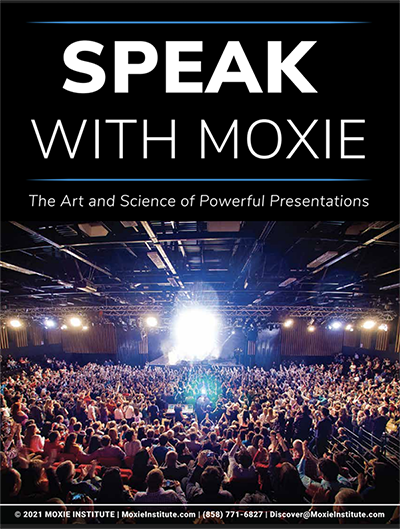Want celebrity swagger? This time- tested technique adapted from our public speaking training can help.
Your vision tunnels inward, especially under the spotlights. And speaking? Forget it. You’re not even sure you can breathe right now.
They say a fear of public speaking is the most common phobia. But speaking isn’t so much the fear; failing to speak is. What if you forget your lines? Or your hands shake noticeably? You look down… hey, you wore pants– that’s a plus.
It’s completely natural to be nervous before you present. There are many factors you can’t control when you’re giving a talk and that’s scary. But in the days and hours before you present, you truly can prepare and control other factors.
In fact, you can even polish your panache and rehearse until you are so confident that you adopt that brazen Broadway swagger that we admire in celebrities. You know, the “It Factor.” Je ne sais quoi. Sprezzatura. Star quality.
Call it what you will– in any language, there’s a certain indefinable quality of natural grace and power. We know it when we see it.
Table of Contents
TogglePRACTICE MAKES PRESENCE
You were probably hoping for a different solution. The process of memorization can be monotonous, right? However, our experience leading public speaking trainings has taught us that our clients do best when they start rehearsing six weeks out from their speech.
So, we know you’re wondering, “why don’t I just wing it?” Our short answer is, “no.” Our long answer is, “for the love of all that is good, please no.” A speech can still seem casual and off the cuff with good preparation. “Winging it” never works.
You see, we’ve witnessed too many speeches (both during practice in public speaking training and out in the wild) as the speaker suddenly careens off topic, winding through strange emotional sharings, and finally crashing into what we’ve named “Uncanny Valley.” This is the uncomfortable event where a speaker suddenly loses all traces of personality and stares at a strange space in the back of the room. (Note: this is not ideal.)
Even the great Mark Twain has famously commented, “it usually takes me more than three weeks to prepare a good impromptu speech.”
Rehearsing is what makes you stand apart from all the other presentations and rewards you with that star powered swagger that makes them say, “wow! She’s got moxie.”
You’ll know you’ve practiced enough when your speech sounds authentic without reading verbatim. This will help you to truly be present as you present. In fact, you’re even minimizing your body’s fight or flight response by knowing what comes next.
SIMPLIFY TO SOLIDIFY
Our favorite low-tech way to reinforce a speech is by using simple phrases as cues on note cards. That will keep you from seeming robotic and stiff, which can happen if you try to memorize every single word or read verbatim from a script.
DISCIPLINE CAN DAZZLE
As we teach in our public speaking training, discipline in rehearsal for actors and public speakers is essential for a quality production.This gives you the opportunity to safely make mistakes and correct them before an audience sees them.
By the time you present, it isn’t the first time you’ve given the talk, it’s the fifth or sixth time (or more.) And don’t forget to become familiar with the space and the technology you will be using.
The more you practice, the easier it will get, and the more confidence you will have. The more confidence you have, the closer you get to the star power of the “It Factor.”
And that will make you and your speech mesmerize them– thank goodness you memorized.
The ideas shared in this article are based on information in our Speak with Moxie e-book. To get the full action-packed book immediately at your fingertips, you can find it here.
Fia and Gregg Fasbinder
CEO and President
www.MoxieInstitute.com
hello@moxieinstitute.com
(858) 771-6827










